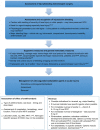Antithrombotics in trauma: management strategies in the older patients
- PMID: 29042825
- PMCID: PMC5633276
- DOI: 10.2147/JBM.S125209
Antithrombotics in trauma: management strategies in the older patients
Abstract
The ageing population has resulted in a change in the demographics of trauma, and older adult trauma now accounts for a growing number of trauma admissions. The management of older adult trauma can be particularly challenging, and exhibits differences to that of the younger age groups affected by trauma. Frailty syndromes are closely related with falls, which are the leading cause of major trauma in older adults. Comorbid disease and antithrombotic use are more common in the older population. Physiological changes that occur with ageing can alter the expected clinical presentation of older persons after injury and their susceptibility to injury. Following major trauma, definitive control of hemorrhage remains essential for improving outcomes. In the initial assessment of an injured patient, it is important to consider whether the patient is taking anticoagulants or antiplatelets and if measures to promote hemostasis such as reversal are indicated. After hemostasis is achieved and bleeding has stopped, longer-term decisions to recommence antithrombotic agents can be challenging, especially in older people. In this review, we discuss one aspect of management for the older trauma patients in greater detail, that is, acute and longer-term management of antithrombotic therapy. As we consider the health needs of an ageing population, rise in elderly trauma and increasing use of antithrombotic therapy, the need for research in this area becomes more pressing to establish best practice and evidence-based care.
Keywords: anticoagulation; antiplatelet; antithrombotic; elderly; injury.
Conflict of interest statement
Disclosure The authors report no conflicts of interest in this work.
Figures


References
-
- National Institute for Health and Care Excellence . Major trauma: assessment and initial management. 2016. (NICE Guideline [NG39]). - PubMed
-
- TARN TARN 2017 report: major trauma in older people. 2017. [Accessed September 7, 2017]. Available from: https://www.ons.gov.uk/peoplepopulationandcommunity/populationandmigrati....
-
- Cooper Z, Maxwell CA, Fakhry SM, et al. A position paper: the convergence of aging and injury and the need for a Geriatric Trauma Coalition (GeriTraC) J Trauma Acute Care Surg. 2017;82(2):419–422. - PubMed
Publication types
LinkOut - more resources
Full Text Sources
Other Literature Sources
Research Materials

